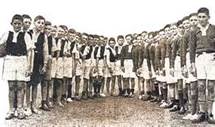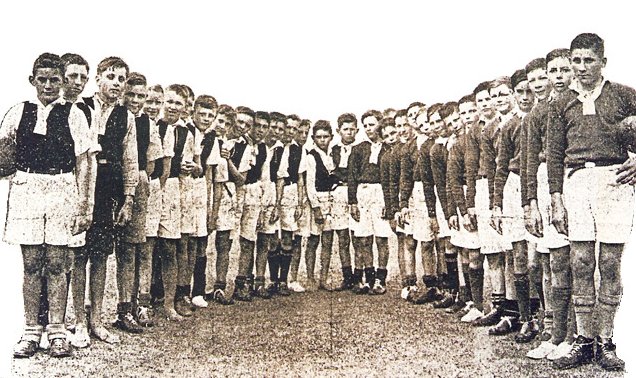School Footy – the Aussie Rules Nursery
- Monday, January 07 2013 @ 06:00 am ACDT
- Contributed by: Wesley Hull
- Views: 5,874

 Do you remember your first Aussie Rules footy match? I remember mine like it was last week. I was running out onto the ground in my Clayton footy jumper. I was so proud. The club wore Collingwood colours (and being an Essendon supporter, I still have involuntary tremors…even today). It was 1972, I felt ten feet tall and….
Do you remember your first Aussie Rules footy match? I remember mine like it was last week. I was running out onto the ground in my Clayton footy jumper. I was so proud. The club wore Collingwood colours (and being an Essendon supporter, I still have involuntary tremors…even today). It was 1972, I felt ten feet tall and….
Hold on a moment! That statement is not correct. Not even close. Why? Because my selection to wear the purple and gold of the Clayton South Primary School footy team pre-dated club football in black and white by a good twelve months. In fact, I still remember my dad suggesting that if I did well enough in the school team, he would let me play in the local league the following year.
I’m quite sure that many readers of this article might also look back into their pasts and find a connection to school footy at some point. The more I think of it, my school days were responsible for some of my greatest footy moments. My first recorded “speccy” attempt was one. I missed the ball and slid quite gracelessly off the back of my opponent step ladder, winding myself. But it was possibly the highest I ever flew. The captain of my high school team in the late seventies was a certain Chris Mew, who would later become an integral part of one of the greatest Hawthorn squads in history through the 80’s and 90’s. In the same team, however, was one kid who went on to play reserves for Essendon and South Melbourne, and another whose older brother was a part of the inaugural Sydney Swans team in 1982. Through school footy I managed to meet some pretty fine players. Actually, in some ways, school footy in my Victorian upbringing was a bit like a “best of” team, with a cross section of some of the finest local talent attending the same school.
But that was a simpler time. It was before computer games and DVD’s. It was before the increased interest in other sports like basketball and soccer. It was before Workplace Health and Safety. It was also at a time where multiple sports were affordable for many. You didn’t choose between sports: you signed up for as many as your parents could afford and get you to.
In my own younger life, school footy was truly the most vital nursery for club footy. So, has that changed?
The answer to that question is so variable it could make a head spin. In answering that question, many other factors need to be considered. For some clubs it will be socio-economic. For others it might be geography and demographics. There are also cultural, social, legal, spiritual or emotional reasons linked together to determine the choices made by families or individuals.
But stripping away the multitude of factors listed, and focusing solely on the value today of school footy, the truest answer seems to be that each club and associated schools will have their own unique situation. Just like people, schools and clubs are not homogenous. A few examples will illustrate this more clearly.
In my playing days it was normal to see kids recruited by AFL clubs straight out of places like Assumption College, St Bernard’s, Mazenod, De La Salle, Haileybury and a seemingly endless list of schools. The Victorian Amateur Football Association (VAFA) still boasts the names of many famous secondary and tertiary educational institutions. That hasn’t really changed, though some teams have come and others gone. Now, however, players seek selection with the pathways available through the TAC Cup and drafting. In the southern states of Australia, school football appears to be just as strong as I remember it, though I’m happy to be corrected on this as I view southern football from afar these days.
But is the situation the same when you move further away from the epicentre of Australian Rules football – Victoria? The southern states?
Cairns, in North Queensland, provides an example of a small city which has a thriving local Australian Rules scene. Not only is it roughly 1700 kilometres from the state capital city, Brisbane, it is almost 3000 kilometres from Melbourne, the recognised home of Australian Rules. The code must compete for players in a population which is strongly supportive of Rugby League. There are many ex-pats in Cairns, so there is a strong smattering of southern experience. But this is not nearly enough. For the game to progress, develop and grow, local schools must become a huge factor in exposing kids to the game in the hope they will be interested enough to give club football a go.
But this is where the start of potential problems can be found. The local AFL bodies in the city do all in their power, with limited resources, to get into all schools and try to convince kids to have a go. But if a particular school does not possess a teacher or parent with the time, expertise and passion to develop the game on site, the interest cannot be sustained, and a local club loses another potential pipeline of kids. In my own school coaching career I have seen schools gain someone who can develop and promote the game, then lose them and see the kids drift back to other codes, especially if those codes are still played at the school.
Brett Kennerley, the President of the Pyramid Power Junior AFL Club to the south of Cairns, originally came from Western Australia. He observed that “back home in W.A, it [school footy] is an integral part of getting kids involved in club footy. But in Cairns this [situation] is in its infancy. I feel that club and school footy need to become entwined, but at the moment there is not enough effort to link the two.”
This opinion is likely to be shared by many people elsewhere who try against the odds to get numbers to keep clubs and leagues going in parts of Australia that are far removed from the game’s movers and shakers. They are working double time (or harder) to get enough market-share of players, funds and resources to stay viable. But a healthy nursery of kids coming through a solid school system can change that status quo dramatically.
The situation is even more difficult outside of Australia in areas trying to grow the game against even greater odds. Without a nursery of school football, there will quite likely never be enough players coming though unless schools are adequately funded, assisted and promoted.
Mike McFarlane is the president and head coach of the North Delta Junior AFL in British Columbia, Canada. Mike is even more reliant on school based Australian Rules clinics and players than any Australian club. Mike states that “For us, doing clinics in schools is our main recruiting ground for our league and has been the reason for our growth. It also allows us to educate people about our sport so they actually know what it is about. From our standpoint there is not enough done to promote footy in schools because we are basically on our own with little or no support from AFL Canada or the AFL [in Australia].” Mike points out that most Australian based teams are at least tapping markets where people have some idea of the game. In Canada this is not the case, with Mike having to educate as he goes, long before getting to the stage of recruiting.
According to Ian Mitchell, the president and head coach of the Wolverhampton Wolverines Australian Football Club in England (and a teacher), school football is vital to the game’s growth there. Ian believes that “School footy in the UK is crucial to the continued development of the game over here. The more schools that introduce the game to youngsters, the more youngsters will take up the game.” He believes that the biggest threats to the development of the game in England are funding, expertise and the links between schools and local clubs.
It appears that the story is the same in Australia and places around the world. Namely, it is the recognition of the importance of school football linking with club football. Clubs need to work with schools, and schools, where possible, need to develop relationships with local clubs. Individuals with passion can make this happen, as can local clubs and football bodies. But unless these links are developed and grown on a wider and more consistent basis, the pool of players is open to shrinking over time. Sadly there are some who simply believe that school football isn’t as important as club football. That has to change.
School football is vital to the development of Australian Rules around the world. Games played at school level need to be treated as being as important to the code as club matches, otherwise they will be seen as irrelevant and disposable. I have coached 78 club games. I have coached 120 school games. From now on my games tally will be a combination of the two to recognise how valuable school football is.
A great deal has changed in the world since I first pulled on the purple and gold jumper of my first school team at Clayton South Primary School. But the value of school football to the future of Australian Rules football has not.
Join me, if you can, in doing whatever can be done to link schools to clubs all over the world. Build those nurseries now to ensure numbers for the future of this great game.

Photo of 1937 Brisbane (Queensland) schoolboy footy Grand Final Australian Rules Teams - Graceville (left) and Goodna (right) State Schools. Courtesy of Gooda State School.


 RSS news
RSS news Twitter
Twitter Facebook
Facebook